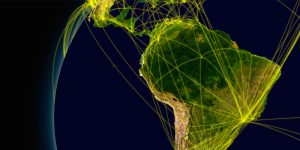In the last 20 years, more than 2.5 billion people have been affected by natural disasters. In only the past few years, Puerto Rico suffered a massive hurricane, wildfires in California destroyed thousands of homes and an earthquake devastated parts of Mexico City.
To help pilot technology that addresses these issues, IBM sponsored Call for Code, a massive, open source challenge that brings together the developer community to solve some of the world’s toughest problems. More than 100,000 developers have contributed, and the results have been astounding. A key theme that emerged in 2018 submissions is connecting people to much-needed aid immediately following natural disasters.
Here are three such disaster relief projects from Call for Code:
1. Project Lantern
After the 2017 earthquake in Mexico City, Suba Udayasankar was determined to help protect her community.
She teamed up with a group of engineers from around the world to create Project Lantern, a combined hardware and software solution that helps people stay connected when normal connections are down.
The solution works by distributing a series of 3D-printed devices called lanterns across the city. The lanterns sync to the cloud when an internet connection is available and store data locally when it is not. All of the lanterns then connect with each other to create a local, offline mesh network. This enables connectivity and communication during disaster scenarios.
Watch the video.
2. Drone Aid
Hurricane Maria left many communities in Puerto Rico struggling to receive aid. Some of the people who needed the most help lived in rural areas where communications were especially challenging.
After seeing the tragic impact on his home island, Pedro Cruz knew he had to do something to help, so he created Drone Aid.
Drone Aid works using a visual vocabulary that drones are programmed to understand. Members of the community are then given signage that communicates in this vocabulary.
When disaster strikes, aid workers can use drones to quickly communicate with victims and shorten response times, even when roads are damaged or unavailable.
Watch the video.
3. WOTA
In the aftermath of the 2011 Tsunami in Japan, some homes were left without running water for as long as three months. Shelters were able to provide drinking water, but without water for showers and washing, victims faced serious health risks.
The solution, developed by Richard Yuwono, Shohei Okudera and Ryo Yamada, is WOTA, a compact, inexpensive water sensor module that uses Internet of Things (IoT) technology to measure properties such as water quality, flow and pressure.
WOTA works by placing modules at multiple locations in the treatment process to monitor the water flowing into and out of filters. The modules send the data to the lab, where the team can analyze quality, predict when filters need to be replaced and detect anomalies. The system can run offline, but when a connection is available, data is sent to the cloud and stored along with user and environmental data.
WOTA makes purification extremely efficient. The system can recover and recycle more than 95 percent wastewater from a shower. WOTA showers are also portable and can be set up at shelters with a single tank of water.
All of this makes it easier for communities to provide disaster victims with access to clean water and help reduce health risks during difficult times.
Watch the video.
Code and Response
IBM leaders were so impressed by Call for Code solutions that there is now an effort in place to turn these ideas into realities. The $25 million, four-year initiative will build, fortify, test and launch open technology solutions to help communities.
Cloud technology has the power to connect devices and bring people together during some of the toughest possible situations.
To learn more about how IBM is working to make these ideas a reality and join the 2019 challenge, visit the official Code and Response webpage.
The post 3 open source solutions that could help mitigate natural disasters appeared first on Cloud computing news.
Quelle: Thoughts on Cloud

Published by